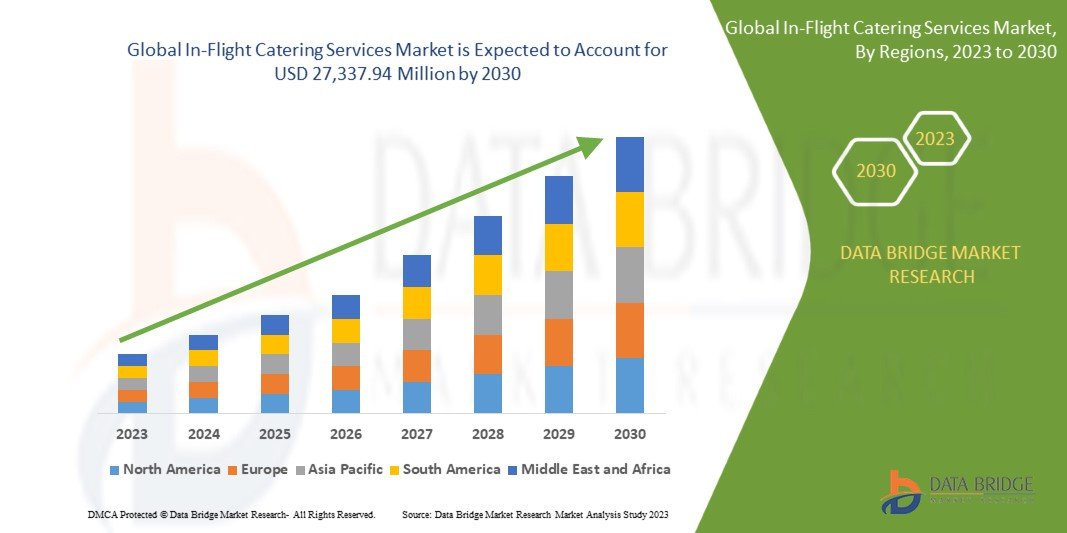In-Flight Catering Services Market: Soaring Demand in a Post-Pandemic Aviation Era
The In-Flight Catering Services Market has rebounded strongly following the downturn caused by the COVID-19 pandemic. As global air travel continues to recover and passenger expectations evolve, airlines are investing in elevated dining experiences to differentiate their offerings, improve customer satisfaction, and boost brand loyalty. This renewed focus on in-flight meals—ranging from luxury business class menus to customizable economy options—is fueling growth in the catering services market worldwide.
Market Overview
In-flight catering services refer to the preparation, packaging, and delivery of meals and beverages served to passengers on commercial and private aircraft. These services are tailored based on factors such as flight duration, travel class, airline policy, passenger demographics, and regional cuisine preferences.
The market consists of full-service providers, specialized meal producers, and airline-operated kitchens, offering everything from snacks and beverages to multi-course gourmet meals.
Key Market Drivers
-
Revival of Air Travel
With travel restrictions easing, international tourism and business travel are on the rise. The increasing number of flights and passengers, particularly in Asia-Pacific and the Middle East, is directly boosting demand for in-flight catering services. -
Rising Passenger Expectations
Today’s travelers demand more than just transportation—they seek a holistic travel experience. Airlines are responding by enhancing their food and beverage offerings to reflect luxury, health, regional identity, and sustainability. -
Airline Differentiation Strategies
Catering is a crucial competitive tool. Full-service carriers are introducing curated menus, celebrity chef collaborations, and regionally inspired dishes, especially in business and first class. -
Focus on Health & Wellness
Post-pandemic, health-conscious passengers are driving demand for organic, plant-based, gluten-free, and low-calorie meal options. Catering companies are innovating to meet these dietary trends. -
Technological Integration
Pre-order meal systems, digitized menu selection, and real-time inventory tracking are improving efficiency and personalization in meal planning and service.
Market Segmentation
| Segment | Sub-Segments |
|---|---|
| By Food Type | Meals, Bakery & Confectionery, Beverages, Snacks |
| By Airline Type | Full-Service Carriers, Low-Cost Carriers, Charter/Private Jets |
| By Flight Duration | Long-Haul, Medium-Haul, Short-Haul |
| By Service Type | Economy Class Catering, Premium Class Catering, Special Meals |
| By Region | North America, Europe, Asia-Pacific, Middle East & Africa, Latin America |
Regional Insights
-
North America: A mature yet lucrative market, driven by high passenger volumes and the presence of major catering providers.
-
Europe: Strong demand for gourmet and customized meal services, especially in premium classes.
-
Asia-Pacific: The fastest-growing region due to booming aviation markets in China and India, and a rising middle-class population seeking enhanced travel experiences.
-
Middle East: Home to luxury carriers like Emirates and Qatar Airways, this region is known for its high-end in-flight dining experiences.
-
Latin America & Africa: Emerging markets with growing regional connectivity and increasing demand for basic in-flight catering solutions.
Key Players in the Market
Leading in-flight catering companies include:
-
Gate Gourmet (gategroup)
-
LSG Sky Chefs (Lufthansa Group)
-
dnata (Emirates Group)
-
DO & CO
-
SATS Ltd.
-
Newrest Group
-
Flying Food Group
These providers operate globally through airline contracts, airport kitchens, and logistics networks, often offering end-to-end catering and inflight logistics services.
Challenges and Constraints
-
Cost Management: Airlines face tight margins and must balance meal quality with cost-efficiency.
-
Food Safety Regulations: Adhering to strict hygiene and regulatory standards across international borders is complex and resource-intensive.
-
Environmental Sustainability: Reducing single-use plastics, food waste, and carbon footprints is a growing priority that adds logistical challenges.
-
Supply Chain Disruptions: Volatility in food supply and global logistics can impact meal quality and delivery timelines.
Future Outlook
The in-flight catering services market is expected to witness sustained growth through 2030, with innovation and customization at its core. Key trends shaping the future include:
-
Smart Catering: AI-driven meal forecasting and inventory optimization.
-
Sustainable Practices: Eco-friendly packaging, waste reduction, and locally sourced ingredients.
-
Premiumization: High-end dining experiences with regional flair, especially in long-haul and business class.
-
Personalized Meal Options: Integration of passenger profiles and preferences into menu planning.
As airlines race to redefine the passenger journey, in-flight catering will remain a pivotal element of customer satisfaction and brand identity.
Get More Details:https://www.databridgemarketresearch.com/reports/global-in-flight-catering-services-market


